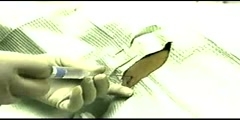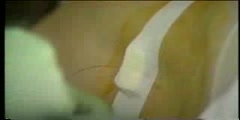Epidural live birth
This babycenter.com video shows epidural live birth. Follow one mom in labor as she decides to get an epidural, feels the numbness set in, experiences pain-free pushing, and gives birth to a healthy baby. Video Transcript/nNarrator: At first, mom-to-be Lisa thought she'd try labor without the help of an epidural, the most common type of pain relief used in childbirth. Her husband, Rob, supported her decision either way. Lisa: She asked several times, and I was being stubborn. Finally I said yes. Narrator: Epidurals are usually given once you're in the active stage of labor. An anesthesiologist places a thin tube into your back so that the medication can flow through it to bathe the nerves around your spine. The anesthetic and narcotic solution blocks the pain signals being sent to the brain and numbs your body from the waist down. Within 20 minutes of starting the epidural, Lisa's pain eases and she feels calm and relieved. Lisa: Yeah, it hasn't been bad. The past couple hours have actually been pretty nice. No pain, no discomfort really. Just getting ready for the baby. Narrator: Lisa has two doctors helping with her epidural-assisted birth at Bryn Mawr Hospital in Pennsylvania. Doctor: Based on these right now, she is contracting every one, two…about every two to three, two to three, two to four minutes. Lisa: The contractions that I can feel are more of a tingling sensation than a painful sensation. I don't feel all of them anymore. Narrator: Dr. Phillip Hirshman is supervising her labor, and her baby will be delivered by Dr. Joseph Castelli. Lisa: I'm looking at the clock and I'm like, okay, we're ready and I'm not freaked out, I'm not in pain, I'm not anxious. I'm, um, it's going to be a much more enjoyable experience. Narrator: For the most part, epidurals are safe and effective. But like all medical procedures, they come with certain risks. Make sure you talk to your doctor about whether an epidural is right for you. Lisa: Does the epidural make everybody itchy? Nurse: Most people it does. It's the fentanyl in that continuous epidural… you're not allergic to it, but it just makes you itch. Nine times out of ten that's what you get, and it's the trunk, it's the belly. Narrator: The most common and minor side effect of an epidural is itchiness, mostly felt on the face, chest, and belly. The itching disappears once the epidural wears off. Because an epidural makes it hard to feel contractions and know when to bear down, it can make pushing more difficult. Doctor: We can allow the density of the epidural, how "thick" the feeling is, to wear off a little bit so that Mom has a little bit more of a sense of urge to push. Narrator: Now that she's dilated to 10 centimeters, Lisa's ready to push. She gets coaching from her nurse and support from Rob. Doctor: We try to get three pushes in for every contraction. Nurse: During an epidural, with pushing, a patient needs help with their legs and instructing on when a contraction is occurring, because they can't feel that pressure. Lisa: Once I could feel where the pressure was and I could try to gauge my pushes towards that pressure, it didn't hurt, it was just tiring. Narrator: As the baby's scalp appears, Dr. Castelli arrives to guide Lisa through the final stages of pushing. After 45 minutes of well-paced pushing, her baby is almost here. Doctor: That's it. Keep it coming, let's bring that baby underneath that pubic bone. Now just a nice gentle push. Good job, okay, good job, just breathe. Narrator: The baby's nose and mouth are suctioned. Doctor: It's a cute baby…okay, we have one loose nuchal cord, one little cord very loose around the baby…. Okay, give a little push… Okay, good, you can stop now. That's it. And we're just going to gently guide the baby out. It's a… what is it… it's a girl! Nurse: Congratulations. Nurse: 11:54. Narrator: As mom and baby meet for the first time, Lisa's doctor stitches up a small tear to her perineum that occurred during delivery. This procedure normally requires a local anesthetic, but Lisa is still numb and pain-free thanks to her epidural. Doctor: Congratulations... she's beautiful. Lisa: Her name is Jules, and she was born at 11:54, and she is 6 pounds, 11 ounces, and 20 and a half inches long. Nurse: She looks great. Narrator: One hour after delivery, the effects of Lisa's epidural are wearing off. Lisa: I don't have a headache. My right side of my body got a lot more epidural and it's taking a little bit longer for that one to get back to normal. There's a sensation like pins and needles but without the pain that goes along with pins and needles. It's just tingly all over. Narrator: Within two hours, she's standing unassisted. Lisa: That's amazing. Pretty much back to me now, which is nice. Narrator: For Jules' mom, Lisa, an epidural was a great option. Lisa: It made the whole experience so much more enjoyable. The epidural worked fantastically.








